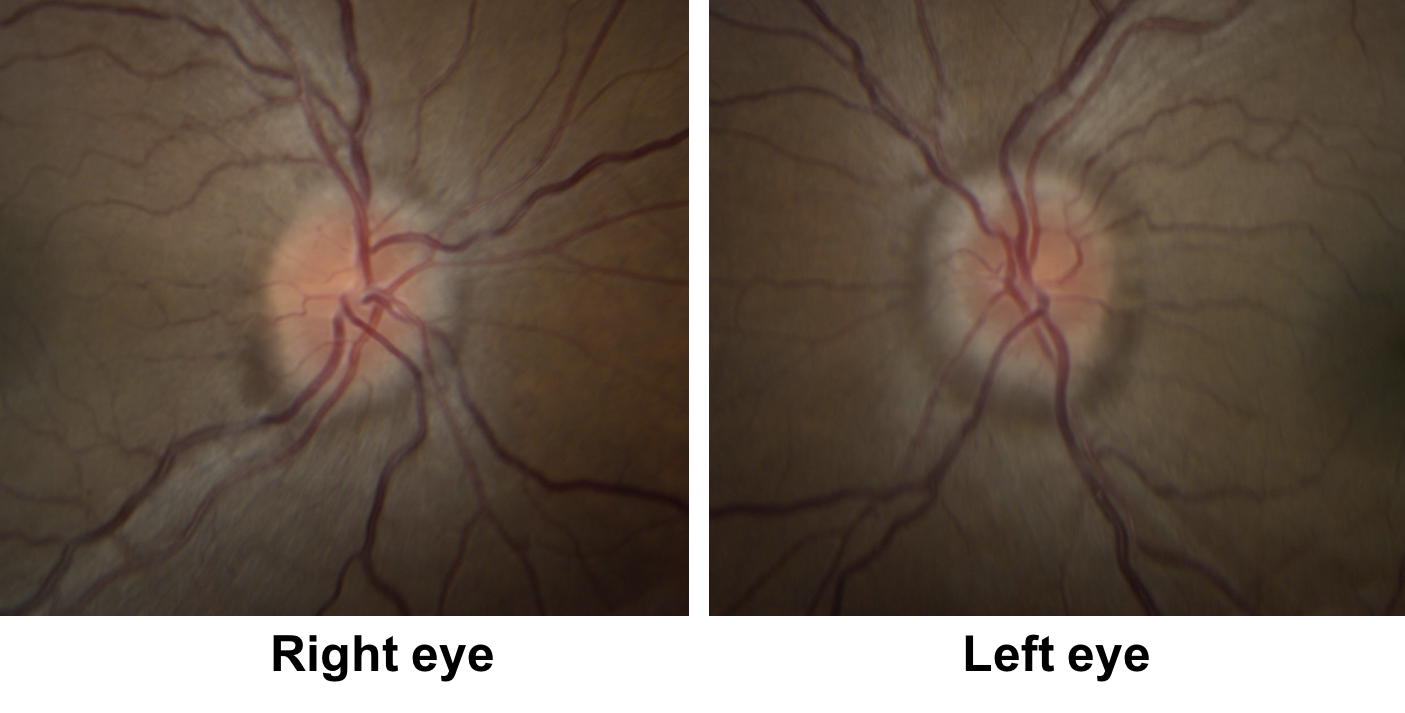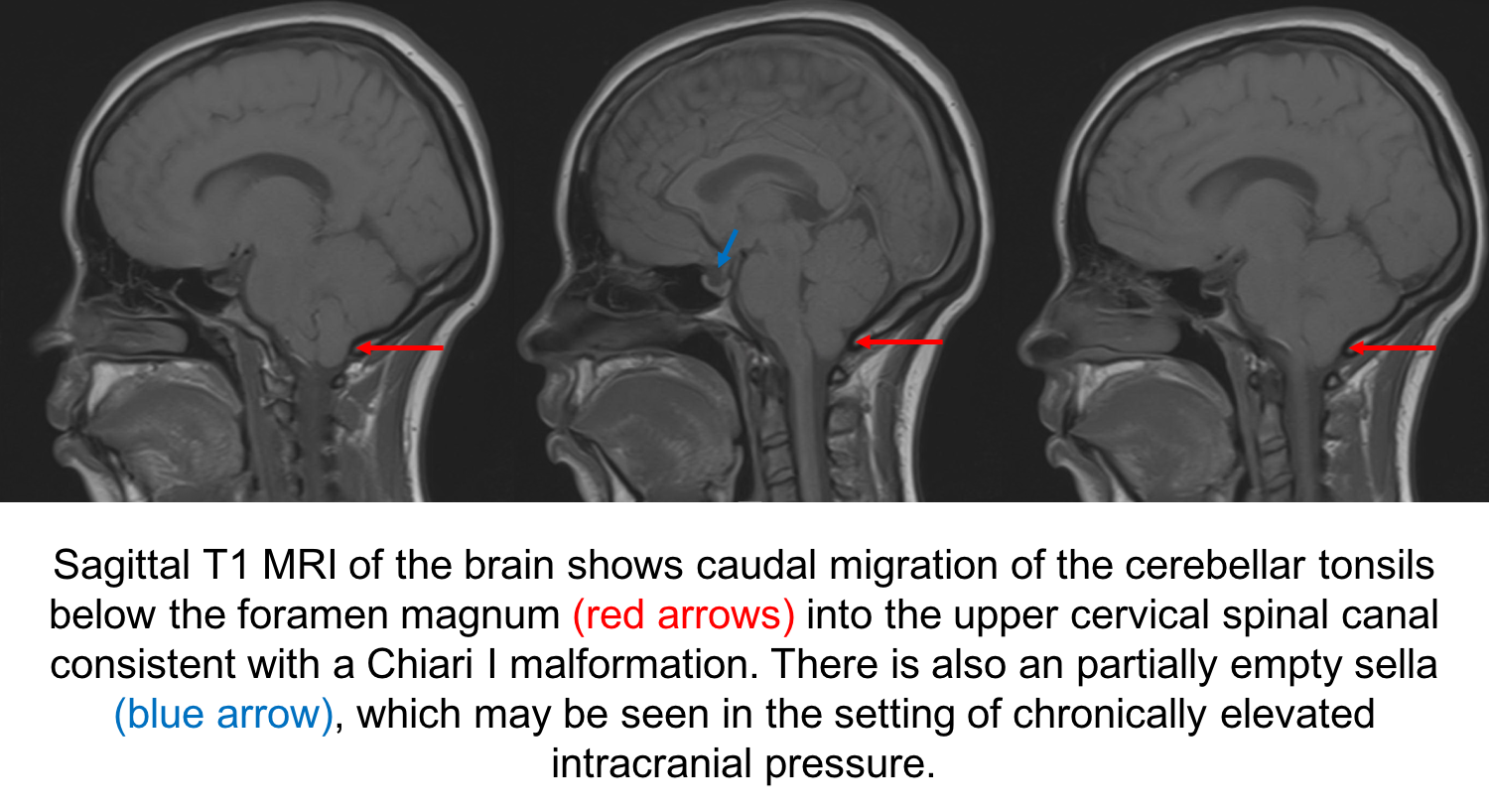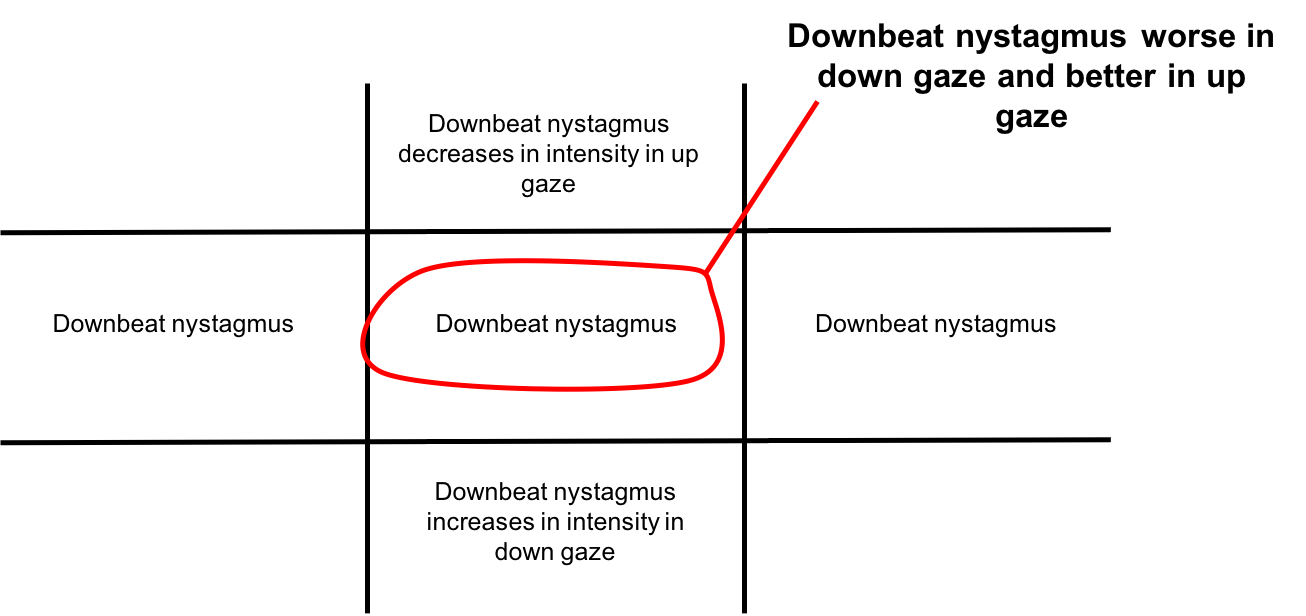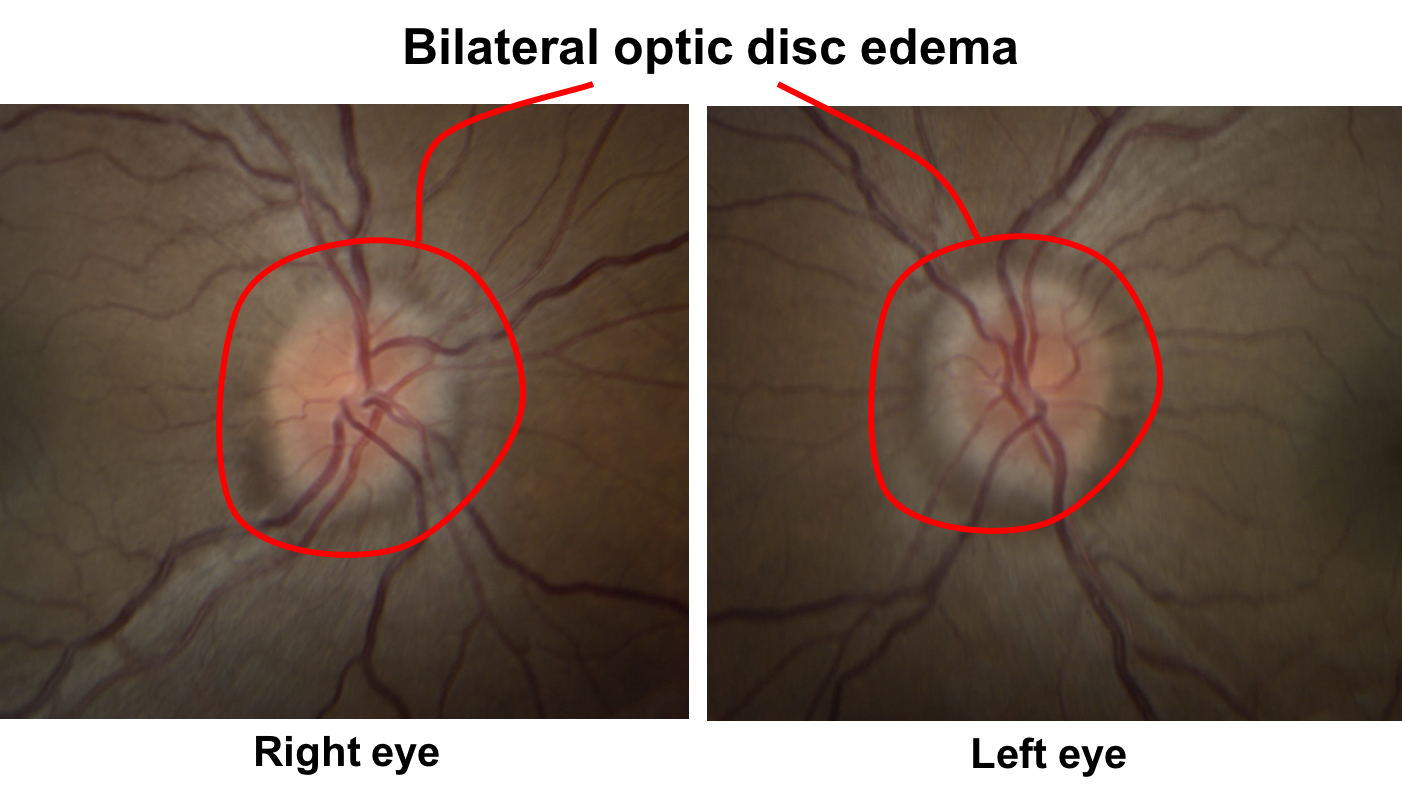25
Case
Age: 31-year-old woman
Reason for referral to ophthalmology: Nystagmus
Past medical history: Hypertension
Past ocular history: None
Medications: Amlodipine
Habits: Non-smoker and does not drink alcohol
HPI: She has had pain at the back of her head and neck for about 1 year that is worse with coughing or straining. A few months ago, she started to notice her vision shaking up and down and difficulty with her balance. She saw her primary care physician who saw nystagmus and arranged for an ophthalmology consultation. Her BMI is 19 kg/m2.
Ophthalmological examination:
Blood pressure: 120/85, heart rate 70
Visual acuity: 20/25 OD, 20/25 OS
Pupils are equal sizes, reactive, there is no RAPD
Color vision: 14/14 correct Ishihara plates in both eyes
Slit lamp examination is normal



1. Downbeat nystagmus means:
- The slow phase of nystagmus is in a downward direction
- The fast phase of nystagmus is in a downward direction
- There is both a slow and fast downward phase
- None of the above
1. Downbeat nystagmus means: 2. The fast phase of nystagmus is in a downward direction
Downbeat nystagmus is a type of jerk nystagmus, meaning there is a slow drift of the eyes in one direction followed by a quick, resetting saccade in the opposite direction. Jerk nystagmus is named by the direction of the fast phase. A patient with downbeat nystagmus has slow upward phase followed by a quick downward phase.
2. Does this patient’s nystagmus follow Alexander’s law?
- Yes, since the intensity (amplitude and frequency) increases in down gaze
- Yes, since the intensity increases in up gaze
- No, since the intensity should increase in up gaze
- No, since the intensity should increase in horizontal gaze directions
2. Does this patient’s nystagmus follow Alexander’s law? 1. Yes, since the intensity (amplitude and frequency) increases in down gaze
Alexander’s law states that the nystagmus increases in intensity (amplitude and frequency) as the eyes are moved in the direction of the fast phase. Like most patients with downbeat nystagmus, this patient’s nystagmus increases in intensity in down gaze.
3. What is the difference between jerk and pendular nystagmus?
- Jerk nystagmus has a slow and a quick phase whereas pendular nystagmus has two slow phases
- Jerk nystagmus has two quick phases whereas pendular nystagmus has only one
- Jerk nystagmus occurs in multiple directions whereas pendular nystagmus only occurs in one
- Jerk nystagmus occurs in multiple horizontal directions whereas pendular nystagmus occurs in multiple vertical directions
3. What is the difference between jerk and pendular nystagmus? 1. Jerk nystagmus has a slow and a quick phase whereas pendular nystagmus has two slow phases
As discussed above, jerk nystagmus consists of a slow drift in one direction followed by a quick movement in the opposite direction. In contrast, pendular nystagmus consists of slow movements in both directions (to-and-fro oscillations).
4. What clue from the clinical history suggests that this nystagmus is acquired rather than congenital?
- The patient has oscillopsia
- The patient has opsoclonus
- The patient has hypertension
- The history is not helpful in this area
4. What clue from the clinical history suggests that this nystagmus is acquired rather than congenital? 1. The patient has oscillopsia
Oscillopsia is a characteristic of acquired, pathologic nystagmus and refers to the drifting of stationary retinal images that degrades vision and produces an illusion of motion. Patients with congenital nystagmus do not have oscillopsia and this is an important factor from the history that helps differentiate congenital from acquired nystagmus.
Clinical Pearl
Oscillopsia is an illusion of motion of the stationary world. Acquired nystagmus is usually associated with oscillopsia whereas congenital nystagmus is not.
5. Where in the central nervous system does downbeat nystagmus localize?
- Craniocervical junction
- Cerebellum
- All of the above
- None of the above
5. Where in the central nervous system does downbeat nystagmus localize? 3. All of the above
Downbeat nystagmus is most commonly associated with diseases affecting the cerebellum or craniocervical junction.
Clinical Pearl
Downbeat nystagmus localizes to the cerebellum or craniocervical junction.
6. Which of the following may cause downbeat nystagmus?
- Chiari malformation
- Cerebellar degeneration
- Multiple sclerosis
- Medications
- All of the above
6. Which of the following may cause downbeat nystagmus? 5. All of the above
In a review of 117 patients with downbeat nystagmus, there was an identifiable cause in 62% and 38% were idiopathic. The most common causes were cerebellar degenerations from spinocerebellar ataxia, posterior fossa vascular lesions, sporadic onset adult ataxia, craniocervical malformations, and Chiari malformations. Other causes include medication use, chronic ethanol abuse, paraneoplastic causes, multiple sclerosis, and nutritional deficiencies.
7. Which of the following is the next best course of action for this patient?
- MRI of the brain
- Lumbar puncture
- CBC, ESR, and CRP
- Vasculitis workup
7. Which of the following is the next best course of action for this patient? 1. MRI of the brain
In this patient with oscillopsia, downbeat nystagmus, and bilateral optic disc edema with normal visual function, which is highly suggestive of papilledema, an MRI of the brain should be performed. There is high concern for a structural lesion, particularly one at the craniocervical junction.

Clinical Pearl
There are different types of Chiari malformations:
- Chiari I malformation: downward displacement of cerebellar tonsils through the foramen magnum
- Chiari II malformation: downward displacement of cerebellar vermis and medulla through the foramen magnum. There is often compression of the 4th ventricle leading to obstructive hydrocephalus and a lumbosacral spinal myelomeningocele.
The patient had a cine phase contrast MRI (specialized MRI that assesses CSF flow across the foramen magnum), which showed impairment of CSF flow at the level of the foramen magnum. She underwent posterior foramen magnum decompression and her nystagmus and papilledema resolved.
8. Which of the following pharmacological treatments can be used for a patient with idiopathic downbeat nystagmus?
- Chlorzoxazone
- 4-aminopyridine
- 3,4-diaminopyridine
- Clonazepam
- All of the above
8. Which of the following pharmacological treatments can be used for a patient with idiopathic downbeat nystagmus? 5. All of the above
A number of pharmacological agents have been reported to improve downbeat nystagmus. These include the GABA agonist, clonazepam, and potassium channel blockers, 4-aminopyridine and 3,4-diaminopyridine, and a selective activator of calcium-activated potassium channels, chlorzoxazone.
9. A patient is observed to have right-beating nystagmus in primary position. When you return to the room a few minutes later, the patient has left-beating nystagmus. What is this type of nystagmus called?
- Pendular nystagmus
- Dissociative nystagmus
- Periodic alternating nystagmus
- Brun’s nystagmus
9. A patient is observed to have right-beating nystagmus in primary position. When you return to the room a few minutes later, the patient has left-beating nystagmus. What is this type of nystagmus called? 3. Periodic alternating nystagmus
Periodic alternating nystagmus (PAN) is a type of horizontal nystagmus that reverses direction every 90 to 120 seconds. In this patient, the right-beating nystagmus is followed by a brief transition period where there may be upbeating or downbeating nystagmus or saccadic movements before the left-beating nystagmus begins.
Clinical Pearl
Periodic alternative nystagmus localizes to the nodulus and uvula of the cerebellum.
10. What treatment is recommended for patients with periodic alternating nystagmus?
- Gabapentin
- Clonazepam
- 4-aminopyridine
- Baclofen
10. What treatment is recommended for patients with periodic alternating nystagmus? 4. Baclofen
Baclofen is very effective in suppressing acquired periodic alternating nystagmus and is usually started at a dose of 5 mg three times per day and then titrated up depending on the response and side-effects. The main side-effect of Baclofen is drowsiness, which may decrease with time. Those who are refractory to Baclofen may respond to Memantine.
11. A patient’s right eye elevates and intorts while her left eye depresses and extorts. A visual field is performed and shows a bitemporal hemianopia. Which of the following is the next best step in evaluating this patient?
- Carotid dopplers
- MRI of the brain
- Lumbar puncture
- Single fiber EMG
11. A patient’s right eye elevates and intorts while her left eye depresses and extorts. A visual field is performed and shows a bitemporal hemianopia. Which of the following is the next best step in evaluating this patient? 2. MRI of the brain
This patient has seesaw nystagmus where one eye elevates and intorts while the other depresses and extorts. The lesion producing see saw nystagmus usually localizes to the sellar/diencephalic region of the brain. Thus, the best next test in this patient is an MRI of the brain to evaluate the sellar region as well as diencephalon (thalamus, hypothalamus and third ventricle). It may also occur in the setting of trauma and congenital optic chiasm abnormalities such as septo-optic dysplasia.
12. A patient has a low-frequency, large-amplitude nystagmus when he looks to the right and a high-frequency, small-amplitude nystagmus when he looks to the left. What is most likely to be seen on his MRI of the brain?
- Frontal lobe tumor
- Cerebellar tumor
- Parasellar tumor
- Cerebellopontine angle tumor
12. A patient has a low-frequency, large-amplitude nystagmus when he looks to the right and a high-frequency, small-amplitude nystagmus when he looks to the left. What is most likely to be seen on his MRI of the brain? 4. Cerebellopontine angle tumor
The type of nystagmus described in this question is characteristic of Bruns’ nystagmus. This is characterized by a low-frequency, large-amplitude nystagmus when looking towards the side of the lesion and a high-frequency, small-amplitude nystagmus when looking away from the lesion. It is often seen with large tumors of the cerebellopontine angle such as meningiomas or schwannomas of the vestibulocochlear nerve.
13. A patient has a vertical pendular nystagmus that developed several months after a brainstem stroke. What should you ask the patient to do to see the classically associated physical exam finding?
- Close his eyes for 1-2 minutes
- Open his mouth
- Stand from a seated position
- Perform a rapid alternating movement
13. A patient has a vertical pendular nystagmus that developed several months after a brainstem stroke. What should you ask the patient to do to see the classically associated physical exam finding? 2. Open his mouth
Oculopalatal myoclonus is a condition that develops several months after brainstem or cerebellar infarction. It is characterized by a vertical pendular nystagmus and synchronous rhythmic movements of the palate, although movements of the facial muscles, pharynx, tongue, larynx, and diaphragm may also be seen. The main pathologic finding in patients with this condition is hypertrophy of the inferior olivary nucleus, which may be seen on MRI. It has been proposed that a disruption in the “triangle of Guillain and Mollaret” consisting of projections between the dentate nucleus in the cerebellum, inferior olivary nucleus in the medulla, and red nucleus in the midbrain are responsible for this condition. However, neither the red nucleus nor the dentate nucleus have been shown to have a specific role in ocular motor function and the nystagmus may result from instability of the connections between the inferior olive to the cerebellar flocculus.
14. Which of the following is not a feature of infantile nystagmus syndrome (congenital motor nystagmus)?
- Jerk or pendular pattern
- Presence of a null point
- Oscillopsia
- Diminished by convergence
14. Which of the following is not a feature of infantile nystagmus syndrome (congenital motor nystagmus)? 3. Oscillopsia
Infantile nystagmus usually develops in infancy, but may be present at birth. Since it is a congenital nystagmus, oscillopsia is usually absent. Characteristic features of infantile nystagmus syndrome are summarized below.
Clinical Pearl
Features of infantile nystagmus syndrome include:
- Jerk or pendular pattern
- Uniplanar (remains horizontal in upgaze and downgaze)
- Presence of a null point
- No oscillopsia
- Increasing velocity of slow phase
- Worsened by distant fixation
- Diminished by convergence
- Abolished in sleep
15. Which of the following treatments may be used in the treatment of infantile nystagmus syndrome?
- Patching of one eye
- High plus lenses
- Kestenbaum-Anderson procedure
- Vertically oriented prisms
15. Which of the following treatments may be used in the treatment of infantile nystagmus syndrome? 3. Kestenbaum-Anderson procedure
The Kestenbaum-Anderson procedure is a surgical treatment that moves the attachments of the extra ocular muscles so that the new null point corresponds to each eye’s new central position. This procedure not only shifts and broadens the null zone, but also often decreases the nystagmus outside the null zone. Other treatments that can be considered for infantile nystagmus syndrome include medications such as gabapentin and memantine, prisms that result in increased convergence (eg. 7D base-out with -1D sphere to compensate for accommodation), and prisms that shift the null point.
16. Which of the following is not part of the triad of spasmus nutans syndrome?
- Nystagmus
- Head-nodding
- Anomalous head position
- Optic neuropathy
16. Which of the following is not part of the triad of spasmus nutans syndrome? 4. Optic neuropathy
Spasmus nutans is a condition that usually appears in the first year of life and is characterized by the triad of nystagmus, head nodding, and anomalous head position. It usually resolves spontaneously 1-2 years after onset. The nystagmus is typically a low-amplitude with a high-frequency, pendular waveform and can sometimes be monocular. A spasmus nutans-like nystagmus has been seen in children with chiasmal or suprachiasmal tumors and some clinicians advocate neuroimaging for all children with spasmus nutans.
Clinical Pearl
The triad of spasmus nutans includes:
- Nystagmus (low-amplitude, high-frequency)
- Head nodding
- Anomalous head position
17. A patient has involuntary saccades that are rapid and multidirectional without an intersaccadic interval. This is called?
- Oscillopsia
- Opsoclonus
- Jerk Nystagmus
- Myoclonus
17. A patient has involuntary saccades that are rapid and multidirectional without an intersaccadic interval. This is called? 2. Opsoclonus
Opsoclonus, also known as saccodomania, presents as multidirectional eye movements that are rapid and multidirectional without an intersaccadic interval. The pathology of opsoclonus is unknown, but may relate to dysfunction of the omnipause neurons in the pons.
18. How does ocular flutter differ from opsoclonus?
- Eye movements are only in the vertical direction
- Eye movements are only in the horizontal direction
- Eye movements are larger amplitude
- Eye movements are lower frequency
18. How does ocular flutter differ from opsoclonus? 2. Eye movements are only in the horizontal direction
Ocular flutter is similar to opsoclonus in that there is no intersaccadic interval, but eye movements are only in the horizontal direction. Ocular flutter also tends to present as small-amplitude, very high frequency movements.
19. Which of the following may cause opsoclonus?
- Viral encephalitis
- Paraneoplastic disorders
- Toxins
- Multiple sclerosis
- All of the above
19. Which of the following may cause opsoclonus? 5. All of the above
A cause of opsoclonus may be identified in about 50% of cases. A paraneoplastic disorder must be ruled out in patients with opsoclonus or ocular flutter. In children, neuroblastoma must be ruled out and in adults, small cell carcinoma of the lung and cancer of the breast and ovaries are of particular concern. Other reported causes include infection, multiple sclerosis, toxins, hyperosmolar coma and intracranial tumors. Post-viral infection is a common etiology of opsoclonus, which usually spontaneously resolves.
Case Summary
She had the new onset of oscillopsia, headache, neck pain and difficulty with her balance and was found to have downbeat nystagmus, bilateral disc edema and ataxia. MRI of the brain revealed a Chiari I malformation with impairment of CSF flow, which was confirmed with CSF flow studies (cine MRI). She underwent posterior foramen magnum decompression and her symptoms and papilledema resolved. She did not have nystagmus at her 6 months follow-up and her optic disc edema resolved.



Further reading:
-
Wagner JN, Glaser M, Brandt T, Strupp M. Downbeat nystagmus: aetiology and comorbidity in 117 patients. J Neurol Neurosurg Psychiatry 2008;79(6):672-7. https://www.ncbi.nlm.nih.gov/pubmed/17872983
-
Thurtell MJ, Leigh RJ. Treatment of nystagmus. Curr Treat Options Neurol 2012:14(1):60-72. http://europepmc.org/abstract/med/22072056
-
Thurtell MJ, Leigh RJ. Nystagmus and saccadic intrusions. Handb Clin Neurol 2011;102:333-378. https://www.ncbi.nlm.nih.gov/pubmed/21601073